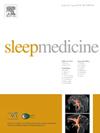中枢性嗜睡障碍(PROM-CDH)患者报告的结果测量:发展和验证
IF 3.4
2区 医学
Q1 CLINICAL NEUROLOGY
引用次数: 0
摘要
研究目的中枢性嗜睡障碍(CDH)对患者的生活质量(QoL)有重要影响。我们开发并验证了一种疾病特异性的患者报告结果测量(PROM)来测量CDH的生活质量:PROM-CDH,用于患有1型和2型发作性睡病(NT1和NT2)和特发性嗜睡症(IH)的成人。方法采用焦点小组和访谈法,对成人CDH患者(27例)、家庭成员(8例)和睡眠医学专家(5例)进行访谈。定量评估中,对369例(疑似)CDH患者在线填写promm -CDH初稿、Epworth嗜睡量表(ESS)、疲劳严重程度量表(FSS)、医院焦虑抑郁量表(HADS)、ADHD评定量表(ADHD- rs)和36项短表(SF-36)。结果总组和诊断组内部一致性良好(所有Cronbach's α >;8)。年龄呈正相关(β = 0.11;P = 0.003),女性(β = - 3.67;P = .002),共病睡眠呼吸暂停(β = - 4.77;P = 0.005),抑郁(β = - 12.71;p & lt;.001)与PROM-CDH评分呈负相关。探索性和验证性因素分析产生五个子量表。收敛效度显示,PROM-CDH总分与HADS抑郁的相关性最高(r = - 0.71;p & lt;. 01);SF-36子量表情绪幸福感(r = 0.65;p & lt;.01)和能量/疲劳(r = .71;p & lt;. 01)。额外的调整包括共识轮中的内容有效性,最终形成了PROM-CDH(2023年版本1)。结论PROM-CDH作为临床试验的重要结果,作为睡眠护理质量的指标,在临床实践中具有较高的应用潜力,可支持临床护理。进一步的国际验证正在进行中,并以多种语言免费提供。本文章由计算机程序翻译,如有差异,请以英文原文为准。

Patient-reported outcome measure for central disorders of hypersomnolence (PROM-CDH): development and validation
Study objectives
Central disorders of hypersomnolence (CDH) have a major impact on patients' quality of life (QoL). We developed and validated a disease-specific patient-reported outcome measure (PROM) to measure QoL in CDH: the PROM-CDH, for adults with narcolepsy types 1 and 2 (NT1 and NT2), and idiopathic hypersomnia (IH).
Methods
The developmental process involved focus groups and interviews with adults with CDH (n = 27), family members (n = 8) and sleep medicine specialists (n = 5). In the quantitative evaluation, the draft version of the PROM-CDH, together with the Epworth Sleepiness Scale (ESS), Fatigue Severity Scale (FSS), Hospital Anxiety and Depression Scale (HADS), ADHD rating scale (ADHD-RS) and the 36-item Short Form (SF-36) were filled out online by N = 369 patients with (suspected) CDH.
Results
Internal consistency was good for the total group and within diagnostic groups (all Cronbach's α > .8). Age was positively (β = .11; p = .003), and female gender (β = −3.67; p = .002), comorbid sleep apnea (β = −4.77; p = .005), and depression (β = −12.71; p < .001) were negatively associated with the PROM-CDH score. Exploratory and confirmatory factor analyses resulted in five subscales. Convergent validity showed highest correlation between the PROM-CDH total score and HADS Depression (r = −.71; p < .01); and the SF-36 subscales Emotional wellbeing (r = .65; p < .01) and Energy/fatigue (r = .71; p < .01). Additional adjustments including content validity in consensus rounds resulted in the final PROM-CDH (version 1, 2023).
Conclusions
The PROM-CDH has high potential in clinical practice for patients with CDH, to support clinical care, as an important outcome in clinical trials, and as a sleep care quality indicator. Further international validation is ongoing, and it is freely available in multiple languages.
求助全文
通过发布文献求助,成功后即可免费获取论文全文。
去求助
来源期刊

Sleep medicine
医学-临床神经学
CiteScore
8.40
自引率
6.20%
发文量
1060
审稿时长
49 days
期刊介绍:
Sleep Medicine aims to be a journal no one involved in clinical sleep medicine can do without.
A journal primarily focussing on the human aspects of sleep, integrating the various disciplines that are involved in sleep medicine: neurology, clinical neurophysiology, internal medicine (particularly pulmonology and cardiology), psychology, psychiatry, sleep technology, pediatrics, neurosurgery, otorhinolaryngology, and dentistry.
The journal publishes the following types of articles: Reviews (also intended as a way to bridge the gap between basic sleep research and clinical relevance); Original Research Articles; Full-length articles; Brief communications; Controversies; Case reports; Letters to the Editor; Journal search and commentaries; Book reviews; Meeting announcements; Listing of relevant organisations plus web sites.
 求助内容:
求助内容: 应助结果提醒方式:
应助结果提醒方式:


